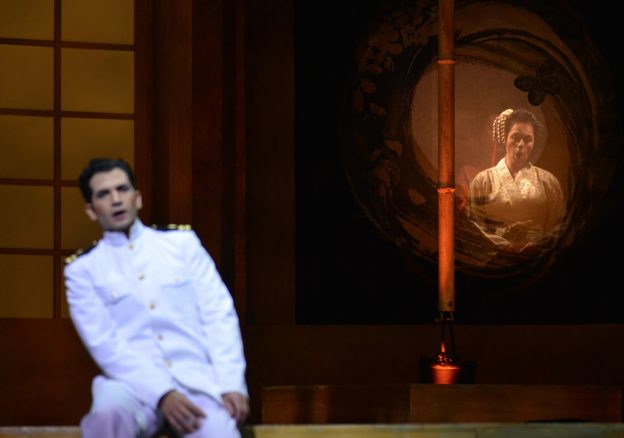
‘Must-see’ Madam Butterfly is HOT!!!
Review: ‘Butterfly’ a must-see at HOT
REVIEW BY JOHN BERGER / jberger@staradvertiser.com
The cultural disconnect is evident immediately: An American officer expects a Japanese businessman to shake hands and is surprised when he bows. Moments later we learn the American, B.F. Pinkerton by name, is an officer but not a gentleman.
| Welcome to Hawaii Opera Theatre’s season-opening production of “Madam Butterfly.” For the benefit of anyone who doesn’t know how Pinkerton’s marriage with Cio-Cio-San turns out, HOT’s production is a beautifully staged treatment of one of the best known operas this side of Wagner. |
(Spoiler alert! Spoiler alert! Stop reading now if you don’t want to know what happens.)
For everyone who thinks they don’t like opera but has read this far out of curiosity, don’t let the opera aspect keep you away. Opera is often portrayed in mainstream pop culture as stuffy or inaccessible or arcane.
Good opera — like HOT’s “Madam Butterfly” — is none of the above. It’s musical theater, albeit without spoken dialogue, and with its own conventions regarding plot structure and vocal performance. That said, musical theater is much more operatic these days than it was in the days of “The King & I,” “West Side Story” and “South Pacific,” and that means that the differences between the two are not as wide as they once were.
Yes, most operas are sung in a language other than English, but anyone who can handle reading the subtitles of films like, say, “Kikaider: Reboot,” can certainly handle the “supertitles” that are projected on the proscenium above the stage at HOT.
In short, Hawaii, don’t let opera scare you. The beauty of the principal voices transcends language. So does the acting.
Add beautiful if anachronistic costumes, imaginative lighting and the single multi-level set, HOT’s “Madam Butterfly” should be considered a must-see for first-timers and curiosity seekers as well as dedicated fans.
Lina Tetriani (Cio-Cio-San) immerses herself in the role of the naïve and idealistic 15-year-old geisha who marries Pinkerton with the expectation that he intends to be her loving husband until death do they part, and who renounces her family, her country and her religious faith for him. To borrow a phrase from William Jefferson Clinton, in Tetriani’s powerful soprano voice and expressive acting we feel her pain. We also feel her hope, her optimism, her joy, and her final commitment to the Japanese credo: “Who cannot live with honor must die with honor.”
Mezzo-soprano Ning Liang (Suzuki) is perfectly cast as the loyal maid. Her duets with Tetriani are exquisite, so are her solos.
Daniel Sutin (Sharpless) brings a rich baritone and appropriate gravity to the role of the American consul. Sharpless warns Pinkerton against his callous plan to discard Cio-Cio-San when it suits him. He then becomes a mute witness to the tragedy that follows. Is he an enabler or a man who shrinks from delivering bad news? Sutin is a commanding presence, vocally and visually, whichever way you see it.
Jamie Offenbach (The Bonze) has a dark and foreboding scene as the terrifying voice of tradition who condemns Cio-Cio-San for renouncing her ancestral religion and becoming a Christian. Lighting Designer Peter Dean Beck has Offenbach lit from below for most of his big number; the stark lighting gives Offenbach an added measure of frightfulness.
Jeffrey Halili (Goro) adds an occasional light moment as the mercenary mariage broker and real estate agent. Halili’s eyes sparkle in an early scene when Goro counts the money Pinkerton has given him. Halili also does a neat trick with his hat that likewise brings a touch of levity to
Eric Margiore (Pinkerton) is such a convincing cad that many in the opening night audience booed him during his curtain call — of course there was no question that the boos were for Pinkerton, not for Margiore’s acting or his rich and passionate tenor.
Pinkerton quickly registers as despicable during his first conversation with Sharpless, in contemporary terms he’d be described as a playa. However, when Margiore and Tetriani are working together in the lengthy wedding night scene that closes Act I, Pinkerton seems every bit as in love with Cio-Cio San as she is with him. The long duet, performed as Margiore is undressing Tetriani down to a simple red under-kimono is romantic despite our knowledge of Pinkerton’s long-term plans. It is a remarkable performance by Margiore and Tetriani alike.
And, when Pinkerton returns three years later, bringing his real American wife with him, Margiore makes the man’s self-pitying mea culpa, “guilt will torment me forever,” convincing as well. Margiore again creates a well-rounded character; Pinkerton knows that he has destroyed the happiness of an innocent woman, begs Sharpless to forgive him, and then rushes off, unable to face the woman he’s wronged and leaving others to clean up after him.
Boo! Hiss! Great performance, Margiore!
Director Henry Akina uses giant Japanese lanterns carried by invisible kuroko (stagehands) to heighten the fanciful aspects of the story. The vigil scene — part reality, part dream or hallucination — where Cio-Cio-San spends the night waiting for Pinkerton to come up the hill from his anchored ship is staged in marvelous style. Conductor Ivan Torzs and the HOT Orchestra do justice to Puccini’s score throughout.
As footnote, HOT has presented “Madam Butterfly” several times since its inaugural production in 1961, most recently in 2007, and has moved the story around a bit time wise in terms of the costumes and wigs worn by the performers. It does so this time too.
If we assume that Puccini intended the story to take place in the present, which for him was the first years of the 20th century, well and good, but most of the Japanese men are decked out in the samurai-style hairdos of the Tokugawa-era rather than the modern haircuts representative of the final years of the Meiji era.
———
John Berger has been a mainstay in the local entertainment scene for more than 40 years. Contact him via email at jberger@staradvertiser.com.
